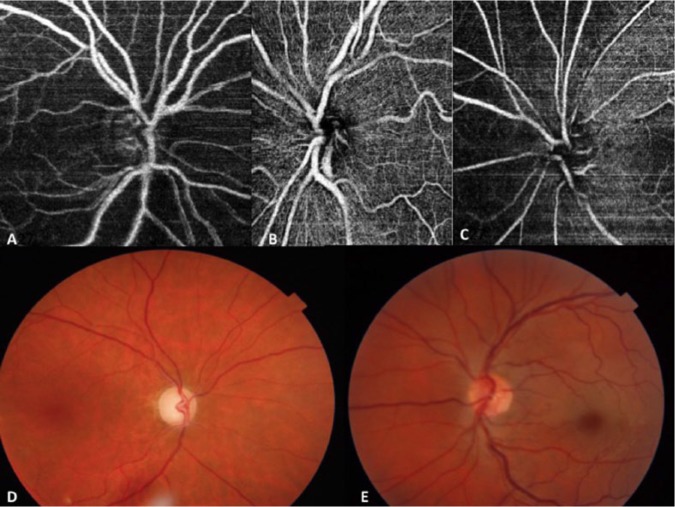Correlation Between Ischemic Retinal Accidents and Radial Peripapillary Capillaries in the Optic Nerve Using Optical Coherence Tomographic Angiography: Observations in 6 Patients.
Ophthalmology and eye diseases
Pub Date : 2017-04-17
eCollection Date: 2017-01-01
DOI:10.1177/1179172117702889
引用次数: 9
Abstract
Background: Perfusion of the optic nerve has been widely studied using fluorescein angiography (FAG), which is currently regarded as the criterion standard. However, FAG has adverse effects associated with intravenous contrast administration and is limited in its capacity to characterize and stratify the different vascular layers of the optic nerve and retina. The use of new imaging techniques, such as optical coherence tomographic angiography (Angio-OCT), is therefore important. Aim: A qualitative description is made of the vascular layers of the optic nerve and of how vascular events affect radial peripapillary capillaries (RPC). Two patients with central retinal artery occlusion (CRAO), 1 with arteritic anterior ischemic optic neuropathy (AAION), and 3 healthy subjects were studied. Results: The Angio-OCT imaging afforded better visualization of the depth of the RPC and rest of the vascular layers of the retina compared with FAG. Optic nerve surface perfusion was affected in AAION and proved normal in CRAO. Conclusions: Our results indicate that perfusion of the papilla and RPC mainly arises from the papillary plexus that depends on the posterior ciliary artery.

光学相干层析血管成像与视神经径向乳头周围毛细血管的相关性:6例观察。
背景:视神经灌注的荧光素血管造影(FAG)已被广泛研究,目前被视为标准。然而,FAG与静脉注射造影剂相关的不良反应,并且在表征视神经和视网膜不同血管层和分层的能力方面受到限制。因此,使用新的成像技术,如光学相干层析血管成像(Angio-OCT),是很重要的。目的:定性描述视神经的血管层和血管事件如何影响径向乳头周围毛细血管(RPC)。研究对象为视网膜中央动脉闭塞(CRAO) 2例,动脉前缺血性视神经病变(AAION) 1例,健康对照3例。结果:与FAG相比,血管- oct成像能更好地显示视网膜RPC深度和其余血管层。AAION组视神经表面灌注受影响,CRAO组视神经表面灌注正常。结论:我们的研究结果表明,乳头和RPC的灌注主要来自依赖于睫状体后动脉的乳头丛。
本文章由计算机程序翻译,如有差异,请以英文原文为准。
求助全文
约1分钟内获得全文
求助全文

 求助内容:
求助内容: 应助结果提醒方式:
应助结果提醒方式:


